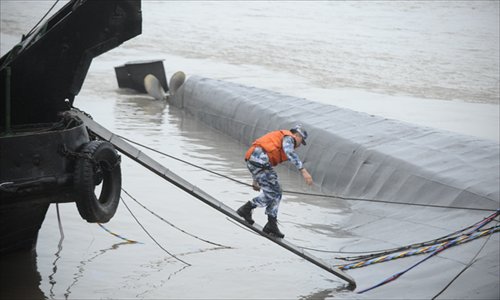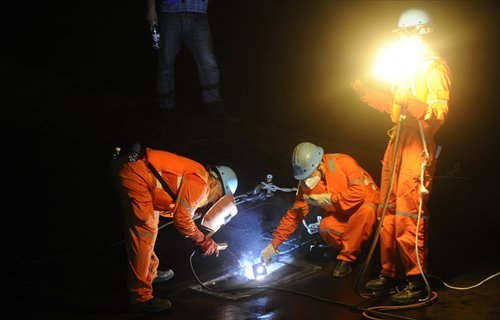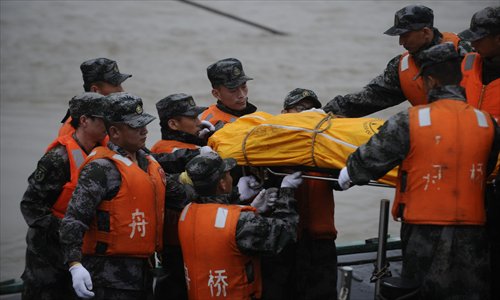Workers cut hull of stricken ship
Turbulent currents hamper rescue as over 400 remain missing

A navy serviceman walks from a rescue boat to the surface of the capsized cruise ship in Jianli, Hubei Province on Wednesday morning to provide assistance to divers who have been taking turns to search for survivors. Photo: Li Hao/GT

Rescuers cut open a hole on the bottom of the capsized ship on Wednesday night. Photo: Li Hao/GT
Workers on Wednesday night started to cut open the hull of the capsized Eastern Star on the Yangtze River in a bid to speed up the search and rescue efforts after the cruise ship carrying 458 people went down in a storm on Monday night.
The death toll from the ship rose to 29 on Wednesday as hundreds of divers searched the ship where more than 400 still remained missing.
The number of survivors remained at 14 as of Wednesday when bad weather, turbulent currents and technical difficulties further eroded any hopes of finding more survivors from the four-story ship.
The ship was caught in a tornado and capsized at around 9:28 pm Monday in a section of the Yangtze River flowing through Jianli county, Hubei Province. The incident is believed to be one of China's worst maritime disasters in decades.
Late Wednesday night, rescuers lifted one end of the ship and began cutting a rectangular hole on the hull of the ship. The hole was meant to give divers better access to the hull, the rescue headquarters at the site told the Xinhua News Agency.
Authorities had previously weighed a different approach where they planned to lift the capsized ship from the water with steel cables, drain the water from cabins and eventually flip the ship over.
A navigation expert, who demanded anonymity, told the Global Times that the second plan could deprive any potential survivors their last chance to be rescued.
"Once the ship is flipped over, water will fill the cabin immediately," the expert said.
As of Wednesday night, rescue divers had identified four air pockets in the ship. According to the Chinese navy, the size of the pockets is limited and the divers found diesel leaks in the water, making the rescue mission even more dangerous, the Hubei Daily reported.
Navy frogmen have completed a search of half of the cabins, even though they faced difficulties such as cabin doors blocked by tables, beds and luggage, Dong Yan, a captain in the Chinese navy and deputy navy director at the rescue scene, told the Global Times.
"The cabins were full of water and were so dark that I felt like I was blind. I couldn't hear anything from survivors. All I could do was to try to feel things with my hands," a diver surnamed Zhang told the Global Times. "If a cabin is searched, we tie a glow stick to its door. Most of the cabins had so much clutter it's hard to enter, and even harder to bring someone out of the room," Zhang said.
According to the Ministry of Transport on Wednesday, turbulent currents remain a major hurdle in the rescue efforts, with the speed of the current reaching 1.8 meters per second.
More than 130 ships and over 200 divers had participated in the rescue operation on Wednesday, authorities said.
Among them, two ships, Xiangyuegong 001 and Qiaochuan 1, each with lifting capabilities of 500 tons, stand by ready to hoist the capsized ship from the water.
Fishermen, outdoor experts and environmental groups have also been combing waters and banks near the capsized ship to find missing passengers. Rescuers have expanded the search area to 200 kilometers downstream.
On Wednesday morning, Chinese Premier Li Keqiang bowed three times to the bodies of the victims in heavy rainfall at the accident site and stood in silent tribute.
Li called for "all-out efforts" and an "overnight battle" to save lives, while instructing rescuers to "mobilize all resources available, take every possible measure and race against time."
Meanwhile, the Office of State Flood Control and Drought Relief Headquarters has ordered the Three Gorges Dam on the upper stream of the Yangtze River to control the water flow from 17,200 cubic meters per second to 7,000 after days of heavy rainfall to aid in the rescue work, China News Service reported.
In a Wednesday press conference hosted by the Ministry of Transport, Chongqing-based shipping expert Zhong Shoudao defended China's ship manufacturing standards.
"We have strict protocols and [every ship built in China] must go through various tests. Eastern Star is a category B [vessel], which means its resistance to wind is only slightly less than for ocean-going vessels."
Zhong claimed that lifesaving equipment on the capsized ship was well-prepared but the accident left people no time to put on life vests. "You've all watched the movie Titanic. The Titanic went down slowly but what happened with the Eastern Star was very fast," he said.

Rescuers carry a body recovered from the wreck of the cruise ship on Wednesday morning in Jianli, Hubei Province. Photo: Li Hao/GT

Graphics: CCTV/GT
Two options to hasten rescue efforts:
Option 1: Cut three holes from the bottom
Pros: The three holes are where passageways are located. That's where passengers could have gathered. Divers can take this short cut to reach the trapped passengers much faster than diving under the capsized ship.
Cons: The leftover air inside the ship may leak from the cut openings, leading to a loss of balance or the ship's immediate sinking. To avoid that, the ship must be fastened to other ships or objects.
Option 2: Lift the ship and turn it upright
Pros: By lifting the bow and stern and turning the capsized ship upright, the search and rescue can be conducted more efficiently and thoroughly.
Cons: The air in the ship's cabins may leak and turning the ship over may hurt potential survivors.
Also, this option will take longer, time that could be spent saving lives.
Global Times
Read more in Special Coverage: